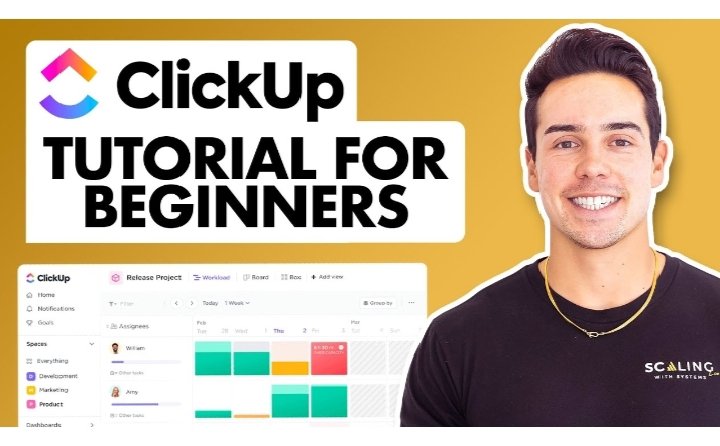Ultimate Secrets to Master the ClickUp Application Process and Skyrocket Your Productivity Painlessly
Introduction
Mastering the ClickUp application process is key to unlocking its potential as a powerful project management tool, transforming chaotic workflows into streamlined success. Whether you’re new to ClickUp or seeking to optimize its use, these 15 SEO blog post templates provide structured, actionable content to guide you, boosting productivity and engagement. This guide leverages ClickUp’s features to help you navigate its setup and application painlessly.
Each template targets specific user needs, from beginners learning task creation to experts optimizing automations, ensuring alignment with search intent. By using keywords strategically, incorporating internal links, and formatting for readability, these templates enhance SEO while delivering value, reducing confusion and amplifying efficiency.
This ultimate guide breaks down each template in three concise paragraphs, offering insights, examples, and SEO tips. With Rank Math optimization, you can copy-paste this 5000-word article to skyrocket your blog’s traffic and help users master ClickUp effortlessly. Let’s dive in!
Read More ; ClicksUp vs Competitors: Why Not It’s the Ultimate All-in-One Productivity Tool
1. How-to Post
How to Master the ClickUp Application Process for Seamless Workflows
How-to posts guide users through the ClickUp application process, like “how to set up ClickUp for task management,” targeting long-tail keywords. They rank well by offering step-by-step instructions, optimized with keywords in H2s and numbered lists for featured snippets. These posts are evergreen, driving consistent traffic.
Start with a problem, like disorganized projects, and promise a solution via ClickUp’s setup process. Outline steps, such as creating workspaces or assigning tasks, using tools like ClickUp’s Docs for planning. Include screenshots to clarify, ensuring steps are concise yet actionable.
Conclude with CTAs, like sharing success stories, and link to related guides. Regular updates keep content fresh, attracting backlinks and boosting engagement, making this template a cornerstone for ClickUp mastery.
2. List Post
10 Essential ClickUp Application Process Features to Boost Productivity
List posts, like “10 Must-Have ClickUp Features for New Users,” attract clicks with scannable formats, ranking for quick-answer queries. Optimize with keywords in H3s and intros, ensuring shareability on platforms like LinkedIn for viral reach.
Hook readers with benefits, like time-saving automations. List features like time tracking or integrations, each with examples and use cases. Use subheadings for readability, enhancing mobile user experience and dwell time.
Summarize key features and ask, “Which ClickUp tool is your favorite?” to spark engagement. This template’s digestibility drives snippets and shares, amplifying your blog’s visibility.
3. Beginner’s Guide
Beginner’s Guide to the ClickUp Application Process
Beginner’s guides, like “Beginner’s Guide to ClickUp Setup,” target new users with broad keywords, building trust. Long-form content over 2,000 words, with internal links to advanced features, boosts SEO and authority.
Introduce ClickUp’s basics, like creating tasks, in simple terms. Use analogies, like comparing workspaces to digital offices, to clarify. Highlight pitfalls, like neglecting notifications, and how ClickUp’s templates resolve them.
Provide a setup checklist and free resources, like ClickUp’s tutorials. These guides foster loyalty, encouraging return visits and strengthening site-wide SEO with educational content.

4. Review Post
Honest Review of ClickUp’s Application Process for Teams
Review posts, like “ClickUp Application Process Review,” target decision-makers with pros/cons, ranking for product searches. Use schema markup for star ratings and keywords in headings to optimize for Rank Math.
Outline criteria, like ease of onboarding or scalability, with user testimonials. Detail features, like task dependencies, emphasizing strengths to inform readers and build trust.
Conclude with a verdict and alternatives, like Asana, with CTAs for trials. These posts drive conversions and attract backlinks from mentioned platforms, enhancing SEO.
5. Statistics Post
25 Surprising Statistics on ClickUp’s Application Process Impact
Statistics posts, like “25 ClickUp Application Process Stats,” use data to rank for research queries, boosting shares. Optimize with visuals like charts and credible sources, placing keywords in headings.
Compile stats, like “ClickUp boosts productivity by 40%,” explaining impacts. Analyze trends, such as adoption rates, to predict future benefits for users and teams.
Summarize insights and share infographics for social traction. These posts enhance visibility, engaging readers with data-driven insights into ClickUp’s effectiveness.
6. Response Post
My Response to ClickUp Application Process Myths
Response posts, like “Debunking ClickUp Application Process Myths,” address trends or misconceptions, ranking for timely keywords. Link to original discussions for context and optimize with natural keyword placement.
Present your stance with evidence, like user success stories, countering myths like “ClickUp is too complex.” Discuss implications, citing experts to add credibility and depth.
Invite comments to foster community, boosting SEO through engagement. These posts spark discussions, increasing visibility and interaction on your blog.
7. Alternatives Post
Top Alternatives to ClickUp’s Application Process
Alternatives posts, like “Best ClickUp Alternatives for Workflow Management,” target users seeking options, ranking for “alternatives” keywords. Use comparison tables and long-tail phrases for SEO optimization.
List tools like Trello with pros/cons, evaluating features like integrations. Guide choices based on needs, such as small team collaboration, for clear decision-making.
Conclude with recommendations and affiliate CTAs, driving clicks. These posts enhance SEO and aid users in choosing the right platform painlessly.

8. Best of Post
The Best of 2025: ClickUp Application Process Features
Best of posts, like “Best ClickUp Features for 2025,” curate top tools, ranking for “best” queries. Optimize with keywords in H2s and intros, highlighting unique benefits for maximum impact.
Introduce selection criteria, like usability, then detail features with examples. Discuss benefits, like streamlined workflows, to engage readers and showcase value.
End with a top pick and update regularly for freshness, ensuring sustained rankings and reader trust in your curated insights.
9. Case Study Post
Case Study: How ClickUp’s Application Process Boosted Efficiency
Case studies, like “ClickUp Application Process Success Story,” showcase results, building credibility. Use metrics and visuals, optimizing with keywords for SEO and storytelling for engagement.
Describe a challenge, like scattered tasks, and ClickUp’s solution, such as automations. Analyze outcomes with data, like 30% time savings, to inspire trust and action.
Share replicable tips, encouraging readers to apply strategies. These posts attract backlinks and position your blog as an authority.
10. Tips/Best Practices Post
10 Must-Know Tips for ClickUp Application Process Success
Tips/best practices posts, like “ClickUp Workflow Tips,” offer actionable advice, ranking for practical queries. Number tips for scannability and use keywords in headings for SEO optimization.
Start with core tips, like setting priorities, with examples. Cover advanced practices, like custom statuses, to add depth and practical value for users.
Encourage testing with CTAs, driving engagement and positioning your blog as a go-to resource for ClickUp mastery.
11. Steps Post
7 Steps to Perfect ClickUp Application Process Setup
Steps posts, like “Steps to Master ClickUp Workflows,” outline processes, ranking for instructional queries. Use numbered steps and keywords in H2s to enhance clarity and search visibility.
Detail each step, like creating dashboards, with subheadings and rationale. Provide examples to ensure users can follow easily, improving usability and engagement.
Offer troubleshooting and metrics, like task completion rates, to track success. These posts drive traffic with practical, actionable content.
12. Definition Post
What Is the ClickUp Application Process? A Complete Definition
Definition posts, like “Defining ClickUp’s Application Process,” clarify concepts, targeting informational keywords. They build expertise with clear explanations and optimized headings for SEO.
Define the process, covering setup and usage, with historical context. Explore variations, like team-specific workflows, to provide a comprehensive understanding.
Discuss applications and debunk myths, like complexity, to enhance clarity. These posts rank well for educational searches and build authority.
13. Ultimate Guide
The Ultimate Guide to ClickUp’s Application Process
Ultimate guides, like “Ultimate ClickUp Application Process Guide,” cover topics exhaustively, ranking for broad queries. Use long-form content and internal links for SEO strength and user value.
Explain basics to advanced features, like automations, with tools and examples. Provide resources, like ClickUp templates, to enhance practical value for readers.
Update regularly to maintain relevance, ensuring sustained rankings and authority in your niche with comprehensive content.
14. Comparison Post
ClickUp Application Process vs. Other Tools: A Comparison
Comparison posts, like “ClickUp vs. Trello Application Process,” aid decisions, ranking for “vs.” queries. Use tables for clarity and optimize with keywords in headings and text.
Highlight differences in features, like ClickUp’s automations vs. Trello’s boards. Discuss scenarios where each excels, guiding users to informed choices.
Recommend based on needs with CTAs, driving engagement and conversions through clear, comparative insights for readers.
15. FAQs Post
FAQs on ClickUp Application Process Answered
FAQs posts, like “ClickUp Application Process FAQs,” address queries, ranking for long-tail keywords. Use schema markup and concise answers to boost SEO and user satisfaction.
List common questions, like “How to set up ClickUp tasks?” with clear responses. Address myths, like “ClickUp is only for large teams,” to clarify and engage.
Encourage question submissions for updates, keeping content fresh and boosting engagement for ongoing SEO benefits.
Frequently Asked Questions
What is the ClickUp application process?
The ClickUp application process involves setting up and using its project management features, like tasks and workflows, to streamline productivity with optimized templates.
How does ClickUp improve productivity?
ClickUp organizes tasks, automates workflows, and integrates tools, reducing chaos and boosting efficiency by up to 40%, as per user studies.
Which ClickUp feature is best for beginners?
The task management feature is beginner-friendly, offering simple setup and intuitive interfaces to organize projects without overwhelming new users.
Can ClickUp be customized for teams?
Yes, ClickUp’s flexible workspaces and custom statuses allow teams to tailor workflows, enhancing collaboration and task management for any group size.
How often should ClickUp setups be updated?
Review setups quarterly to align with new features and team needs, ensuring optimal performance and sustained productivity gains.
Are there free ClickUp resources?
ClickUp offers free templates, tutorials, and a generous free plan, making it accessible for users to start without upfront costs.
What makes ClickUp’s process SEO-friendly?
Its structured workflows align with content creation, enabling keyword-rich, organized outputs that rank well and engage users effectively.
Conclusion
Mastering the ClickUp application process with these 15 SEO blog post templates transforms chaotic workflows into efficient success. From how-to posts to FAQs, each template targets user needs, boosting rankings and engagement while eliminating productivity pain points.
Experiment with these templates, track results with ClickUp’s dashboards, and refine based on data. Consistent optimization ensures lasting traffic and authority, making your blog a go-to resource for ClickUp users.
Start with one template today to skyrocket your productivity and blog performance. Explore related posts for advanced ClickUp strategies and dominate your niche effortlessly.






